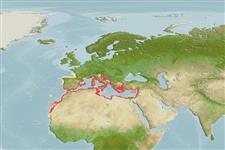Common names from other countries
Teleostei (teleosts) >
Mugiliformes (Mullets) >
Mugilidae (Mullets)
Etymology: Oedalechilus: Greek, oidaleos, -a, -on = swollen + Greek, cheilos = lip (Ref. 45335).
More on author: Cuvier.
Environment: milieu / climate zone / depth range / distribution range
Ecology
Marine; brackish; demersal. Subtropical; 46°N - 20°N, 18°W - 36°E
Eastern Atlantic: Morocco to Gibraltar. Throughout the Mediterranean Sea but not in Black Sea.
Length at first maturity / Size / Weight / Age
Maturity: Lm 12.9, range 11 - 15 cm
Max length : 25.0 cm TL male/unsexed; (Ref. 2804); max. reported age: 10 years (Ref. 93212)
Neritic, found inshore, at mouths of rivers and sewage effluents but not entering brackish and freshwater (Ref. 7465). Oviparous, eggs are pelagic and non-adhesive (Ref. 205).
Life cycle and mating behavior
Maturity | Reproduction | Spawning | Eggs | Fecundity | Larvae
Ben-Tuvia, A., 1986. Mugilidae. p. 1197-1204. In P.J.P. Whitehead, M.-L. Bauchot, J.-C. Hureau, J. Nielsen and E. Tortonese (eds.) Fishes of the North-eastern Atlantic and Mediterranean. Volume 3. UNESCO, Paris. (Ref. 2804)
IUCN Red List Status (Ref. 130435)
CITES (Ref. 128078)
Not Evaluated
Threat to humans
Harmless
Human uses
More information
ReferencesAquacultureAquaculture profileStrainsGeneticsElectrophoresesHeritabilityDiseasesProcessingMass conversion
Tools
Can't connect to MySQL database fbquizv2. Errorcode: Too many connections
